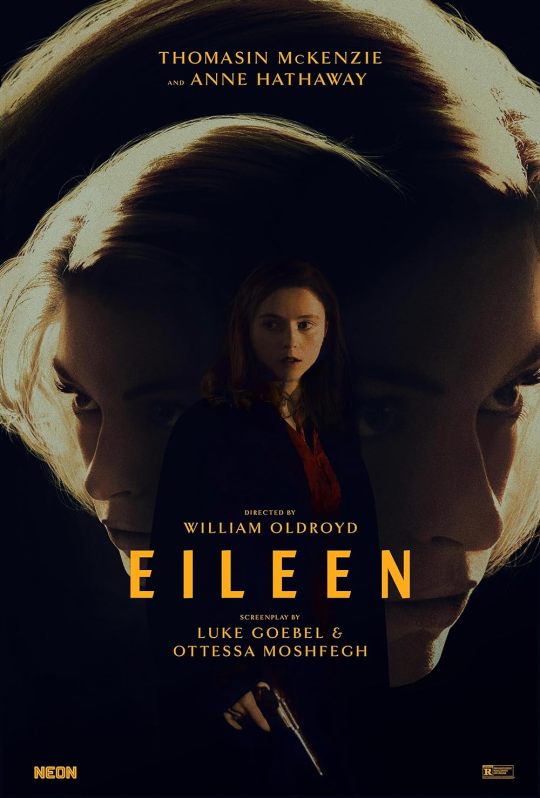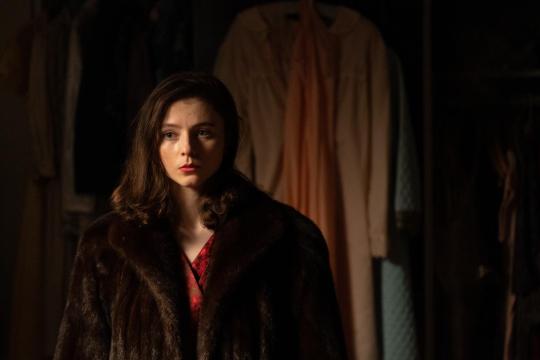#Owen Oldroyd
Explore tagged Tumblr posts
Text
Jury Fury
TWELVE ANGRY MEN The Alexandra Theatre, Birmingham, Monday 30th October 2023 Reginald Rose’s classic play from 1955 is doing the rounds again and it’s well worth catching even if, like me, you have seen it before. Based on Rose’s own experience of serving on a jury, this tense, taut thriller continues to weave its engrossing spell, as a dozen increasingly tetchy males gather in a jury room to…

View On WordPress
#Andy Graham.#Ben Nealon#Birmingham#Chris Davey#Christopher Haydon#Gary Webster#Gray O&039;Brien#Jeffery Harmer#Kenneth Jay#Mark Heenehan#Michael Greco#Owen Oldroyd#Patrick Duffy#Paul Beech#Paul Lavers#Reginald Rose#review#Samarge Hamilton#The Alexandra Theatre#Tristan Gemmell#Twelve Angry Men
2 notes
·
View notes
Text

Eileen (dir. William Oldroyd).
[Its] alluring small-scale, female-driven psychodrama of two women at opposite ends finding attraction in one another's flaws hints at a greater dissatisfaction with mid-century womanhood. Its dark period piece of an almost romance haunts the drab, coldly methodic setting of a boys' prison and offices in suburban Massachusetts.
#eileen#eileen movie#thomasin mckenzie#anne hathaway#neon#indie film#indie movie#movie#movies#movie review#film#film review#cinema#william oldroyd#otessa moshfegh#shea whigham#marin ireland#sam nivola#owen teague#film4#likely story
17 notes
·
View notes
Text

Eileen (2023)
This is a Movie Health Community evaluation. It is intended to inform people of potential health hazards in movies and does not reflect the quality of the film itself. The information presented here has not been reviewed by any medical professionals.
Eileen has one brief scene with very mild, spinning-style police lights. The rest of the film is safe for photosensitive audiences.
All of the camera work in this film is either stationary or very smooth.
Flashing Lights: 1/10. Motion Sickness: 0/10.
TRIGGER WARNING: A character has repeated, visualized fantasies involving suicidal actions. Stories are told involving sexual abuse. After some heavy drinking, a character wakes up in a puddle of vomit, and goes on to vomit on-screen while trying to open a door.
Image ID: a promotional poster for Eileen
youtube
#Movie Health Community#Health Warning#Actually Epileptic#Photosensitive Epilepsy#Seizures#Migraines#Motion Sickness#Neon#Eileen#December#2023#Thomasin McKenzie#Shea Whigham#Marin Ireland#Owen Teague#Anne Hathaway#William Oldroyd#Rated R#Youtube
11 notes
·
View notes
Text






Eileen (2023) William Oldroyd
January 3rd 2024
#eileen#2023#william oldroyd#thomasin mckenzie#anne hathaway#shea whigham#marin ireland#siobhan fallon hogan#sam nivola#owen teague#tonye patano
8 notes
·
View notes
Text
EILEEN:
Vibrant therapist
Breaks coworker out of shell
Feminist noir
youtube
#eileen#random richards#poem#haiku#poetry#haiku poem#poets on tumblr#haiku poetry#haiku form#poetic#thomasin mckenzie#shea whigham#sam nivola#siobhan fallon hogan#Tonya patano#owen teague#william oldroyd#Luke Goebel#ottessa moshfegh#Youtube
7 notes
·
View notes
Text

Films Watched in 2024: 2. Eileen (2023) - Dir. William Oldroyd
#Eileen#William Oldroyd#Thomasin McKenzie#Anne Hathaway#Shea Whigham#Marin Ireland#Owen Teague#Sam Nivola#Films Watched in 2024#My Post
3 notes
·
View notes
Text
'Eileen' Contains Multitudes
'Eileen' Contains Multitudes
Come on, Eileen! (CREDIT: NEON) Starring: Thomasin McKenzie, Anne Hathaway, Shea Wigham, Marin Ireland, Owen Teague Director: William Oldroyd Running Time: 98 Minutes Rating: R for Masshole Behavior and a Sudden Violent Turn Release Date: December 1, 2023 (Theaters) What’s It About?: Eileen Dunlop (Thomasin McKenzie) has a real going-nowhere job as a secretary at a juvenile prison in 1960s…

View On WordPress
3 notes
·
View notes
Text
Eileen

Eileen [trailer]
A woman's friendship with a new co-worker at the prison facility where she works takes a sinister turn.
That was a bit too much crazy for my personal taste.
The gun was presented in such a way that while you didn't know right away who would be shot, it seemed always clear that it will be used one way or another. It screams "Chekhov's gun" very loudly.
#Eileen#William Oldroyd#Thomasin McKenzie#Anne Hathaway#Shea Whigham#Marin Ireland#Siobhan Fallon Hogan#Sam Nivola#Owen Teague
1 note
·
View note
Text
Podcast: Eileen & Next Goal Wins
This week on the show, we’re covering the just-released thriller Eileen, starring Thomasin McKenzie and the incomparable Anne Hathaway, which Matthew first saw at Sundance 2023, and then finally follow up with Taika Waititi’s latest sports underdog story Next Goal Wins. Continue reading Untitled

View On WordPress
#Anne Hathaway#Beulah Koale#David Fane#Eileen#Elisabeth Moss#Kaimana#Marin Ireland#Michael Fassbender#Next Goal Wins#Oscar Kightley#Owen Teague#Rachel House#Shea Whigham#Taika Waititi#Thomasin McKenzie#Will Arnett#William Oldroyd
1 note
·
View note
Text
Eileen (2023) Movie Review
Eileen – Movie Review ABC Film Challenge – Catch-Up 2024 – E Director: William Oldroyd Writer: Luke Goebel, Ottessa Moshfegh (Screenplay) Writer: Ottessa Moshfegh (Novel) Cast Thomasin McKenzie (Last Night in Soho) Anna Hathaway (The Dark Knight Rises) Shea Whigham (Mission Impossible Dead Reckoning) Owen Teague (Bloodline) Sam Nivola (Maestro) Plot: A woman’s friendship with a new…
0 notes
Text
Movie Review: Eileen (2023)
Title: Eileen Release Date: December 8, 2023 Director: William Oldroyd Production Company: Fifth Season | Film4 | Likely Story | Omniscient Films Main Cast: Thomasin McKenzie as Eileen Dunlop Shea Whigham as Jim Dunlop Marin Ireland as Mrs. Polk Owen Teague as Randy Anne Hathaway as Rebecca Sam Nivola as Lee Polk Siobhan Fallon Hogan as Mrs. Murray Tonye Patano as Mrs. Stevens Peter McRobbie as…

View On WordPress
1 note
·
View note
Photo


Monitor shot of Anthony Head as Gerald Plymton & Owen Oldroyd as Henry Wilcott-Steeds in the upcoming UK black comedy Sideshow.
11 notes
·
View notes
Text
Anne Hathaway Recalls Being Asked “Are You a Good Girl or a Bad Girl” – The Hollywood Reporter
Standing on the big stage inside Park City’s Eccles Theatre on Saturday night, Anne Hathaway took the microphone during a brief Q&A session following the world premiere of her new film, Eileen. After saying how honored she is to be in the cast of William Oldroyd’s film alongside Thomasin McKenzie, Shea Whigham, Marin Ireland and Owen Teague, the Oscar winner offered a polite apology if what she…

View On WordPress
0 notes
Text
As Volkswagen Ends Beetle Production, a Final Photo Farewell to the Beloved ‘Bug’
The Volkswagen Beetle has finally completed its road trip.
After 80 years of production in Germany, Belgium, Venezuela, South Africa, and about a dozen other countries, the last ‘Bug’ rolled off the factory line in Puebla, Mexico this week.
The car’s journey to the Puebla Automotive Museum marked the final pit-stop for a vehicle that’s been a symbol of freedom, fun, and counter-cultural cool since it first rolled onto U.S. shores in 1949—despite its Nazi Germany roots.
Wartime beginnings
When Adolf Hitler commissioned auto legend Ferdinand Porsche to create a cheap, reliable “people’s car” (or “Volks Wagen”) in 1933, the Austrian engineer responded by designing a streamlined, yet flat-windowed car, with an air-cooled engine in the rear trunk and storage space under the hood.
Production of the distinctive “KdF-Wagen” came to an abrupt end shortly afterward, as the giant Volkswagen plant in Wolfsburg was re-purposed to manufacture military vehicles for World War II. It was only after the war ended that the British military took ownership of the factory and re-started production of the Bug in the hope that it could help stimulate the shattered German economy.
Adolf Hitler, the German dictator, admires a model of the Volkswagen car and is amused to find the engine in the trunk. Hoffmann/Getty Images

Left: Finished Volkswagen Beetles fill a storage yard at the VW factory near Brunswich, West Germany, circa early 1950s. Corbis via Getty Images Right: Women stare out the back of Volkswagen Beetle in 1953. Courtesy of VW

Volkswagen celebrates its 1 millionth car produced at a production plant in 1955. Herold—picture alliance via Getty Images
But in what would prove to be an ill-conceived move, executives from the major British automakers ultimately decided the Beetle wouldn’t be a hit with post-war car owners and returned the factory to Volkswagen’s ownership in 1949.
“They evaluated the car and the factory and basically said ‘We can’t sell that’,” says Patrick Collins, research officer at from the British National Motor Museum. “It’s like [record label] EMI turning down the Beatles.”
Volkswagen started production almost immediately, and by 1951 it was producing close to 100,000 Beetles a year. By 1965, that figure would grow to over a million.
California cool
In 1960s California, the Beetle came to have an entirely different history.
“In the United States, the Beetle’s characteristics lent it a profoundly unconventional air in a car culture dominated by size and showmanship,” wrote Bernhard Rieger in his 2013 history, The People’s Car. At this stage of its history, the Beetle was primarily rolling into the country from Puebla. In 1968, U.S. buyers snapped up 563,522 Beetles—or 40% of worldwide production—partly fueled by a marketing campaign that was just as quirky as the car itself, with agency Doyle Dane Bernbach urging consumers to “Think Small.”

Beetle production in Puebla, Mexico. Courtesy of VW

Teenagers attending the Los Angeles Teenage Fair line up five-deep to get a chance to sign their autographs on a Volkswagen Beetle, which was then sent to the British singing group The Beatles in 1965. Bettmann/Getty Images
Hollywood also played a key role. Record sales in 1968 coincided with the release of “The Love Bug,” featuring “Herbie” the plucky race car with a mind of its own. Meanwhile, movie star owners like Paul Newman added their own touch of stardust—in Newman’s case by adding a faster Porsche engine to his own Beetle.
“Suddenly everyone had a white Beetle with the number 53 on the side,” says Patrick Collins from the British National Motor Museum. “It put the Beetle into the popular psyche. Kids loved it and for anyone growing up in the ’70s it wasn’t a Beetle, it was ‘a Herbie’.”
At the same time, the car also cornered the customized market, with the Beetle “dune buggy” or beach buggy—a convertible, with large wheels, wide tires and distinctive ‘bug eye” headlamps designed for use on sand dunes, beaches, or the desert. This opened up a different—yet still alternative—audience, particularly in California, though the influence soon had global reach.
“It kept the counter culture of it,” says Collins. “You know, a bit quirky, a bit hippy, a bit ‘way out’—not establishment. Whatever period of its history you look at from the 1930s onwards, the Beetle was always quirky,” he adds. “It never followed the automotive theme of the period.”

A man driving a Volkswagen Beatle on the way to the Woodstock Music Festival in August 1969. Ralph Ackerman—Getty Images

A sign at a gas station during the gasoline shortage and energy crisis in 1974. Owen Franken—Corbis via Getty Images
A Bug’s second—then third—life
Production of the car at the original German factory in Wolfsburg stopped in 1978, when VW decided to turn the page on its past and focus on creating modern, front-drive hatchbacks such as the all-conquering Golf model.
But Bug production continued elsewhere, with the Mexican-made Beetle (nicknamed the “Vochito”) hitting the road from 1967 until 2003–a span that was longer, in fact, than the car’s production run in Germany.
In all, over 21 million “original” Beetles were produced from 1938 to 2003.

Prospective Volkswagen Beetle buyers view the “new” 1998 model of the famous German vehicle in Norwalk, California. Mike Nelson—AFP/Getty Images

Lindsay Lohan in the 2005 film ‘Herbie: Fully Loaded,’ featuring a Volkswagen Beetle. Walt Disney/Everett Collection
The car then discovered a third life in 1998, when VW chief executive Ferdinand Piech—grandson of Ferdinand Porsche—decided the time was ripe for a new Beetle. A modern version of the Bug was born, albeit with an engine in the front and the same chassis andengineas a Golf. The styling, however, was pure Beetle and went on to sell 1.7 million models worldwide.
“In an era where cars are designed in wind tunnels and the trick is to go for a sleek, smooth shape that’s completely aerodynamic, with a few folds in the doors to provide a bit of strength, here you had a car that looked completely different,” Charles Oldroyd, chairman of the Historic Volkswagen Club, said about the newer Beetle.
“The original Beetle was counter-culture and I think the new car kind of hooked onto that: dare to be different,” he adds. “It was a second car. It was a hobby car. It was a fun car.”
But that appeal wasn’t enough to save the Bug. U.S. sales averaged around 1,500 a month in 2018; SUVsnow dominate the U.S. car market, accounting for more than 70% of overall sales. The VW plant in Puebla was the last to produce the Beetle, and it made the inevitable, if painful, decision to manufacture SUVs instead.

The Volkswagen New Beetle sits on display during the world premiere of the 21st Century Beetle on April 18, 2011 in Berlin, Germany. Andreas Rentz—Getty Images

Mariachi musicians play songs with workers and managers of Volkswagen during a ceremony to announce the cease of the production of the VW Beetle after 21 years in the market, at the Volkswagen plant in Cuautlancingo, Mexico on July 10, 2019. Hector Vivas—Getty Images
“[The Beetle] conquered the hearts of the people with its special design and quality,” Steffen Reiche, CEO of VW Mexico said Wednesday in a farewell ceremony to the Bug, complete with mariachi band and confetti.
“Today is the last day. It has been very emotional.”
More must-read stories from Fortune:
—A Brexit architect sees opportunities in resignation of U.K.’s Trump-bashing ambassador
—Fashion retailers sidestepping Trump’s trade war with China
—Ford’s new plan for Europe: Fewer jobs, more SUVs
—The U.S. threatened France with China-style tariffs. The French didn’t blink
—Listen to our new audio briefing, Fortune 500 Daily
Catch up with Data Sheet, Fortune‘s daily digest on the business of tech.
Credit: Source link
The post As Volkswagen Ends Beetle Production, a Final Photo Farewell to the Beloved ‘Bug’ appeared first on WeeklyReviewer.
from WeeklyReviewer https://weeklyreviewer.com/as-volkswagen-ends-beetle-production-a-final-photo-farewell-to-the-beloved-bug/?utm_source=rss&utm_medium=rss&utm_campaign=as-volkswagen-ends-beetle-production-a-final-photo-farewell-to-the-beloved-bug from WeeklyReviewer https://weeklyreviewer.tumblr.com/post/186290306042
1 note
·
View note
Text
As Volkswagen Ends Beetle Production, a Final Photo Farewell to the Beloved ‘Bug’
The Volkswagen Beetle has finally completed its road trip.
After 80 years of production in Germany, Belgium, Venezuela, South Africa, and about a dozen other countries, the last ‘Bug’ rolled off the factory line in Puebla, Mexico this week.
The car’s journey to the Puebla Automotive Museum marked the final pit-stop for a vehicle that’s been a symbol of freedom, fun, and counter-cultural cool since it first rolled onto U.S. shores in 1949—despite its Nazi Germany roots.
Wartime beginnings
When Adolf Hitler commissioned auto legend Ferdinand Porsche to create a cheap, reliable “people’s car” (or “Volks Wagen”) in 1933, the Austrian engineer responded by designing a streamlined, yet flat-windowed car, with an air-cooled engine in the rear trunk and storage space under the hood.
Production of the distinctive “KdF-Wagen” came to an abrupt end shortly afterward, as the giant Volkswagen plant in Wolfsburg was re-purposed to manufacture military vehicles for World War II. It was only after the war ended that the British military took ownership of the factory and re-started production of the Bug in the hope that it could help stimulate the shattered German economy.
Adolf Hitler, the German dictator, admires a model of the Volkswagen car and is amused to find the engine in the trunk. Hoffmann/Getty Images

Left: Finished Volkswagen Beetles fill a storage yard at the VW factory near Brunswich, West Germany, circa early 1950s. Corbis via Getty Images Right: Women stare out the back of Volkswagen Beetle in 1953. Courtesy of VW

Volkswagen celebrates its 1 millionth car produced at a production plant in 1955. Herold—picture alliance via Getty Images
But in what would prove to be an ill-conceived move, executives from the major British automakers ultimately decided the Beetle wouldn’t be a hit with post-war car owners and returned the factory to Volkswagen’s ownership in 1949.
“They evaluated the car and the factory and basically said ‘We can’t sell that’,” says Patrick Collins, research officer at from the British National Motor Museum. “It’s like [record label] EMI turning down the Beatles.”
Volkswagen started production almost immediately, and by 1951 it was producing close to 100,000 Beetles a year. By 1965, that figure would grow to over a million.
California cool
In 1960s California, the Beetle came to have an entirely different history.
“In the United States, the Beetle’s characteristics lent it a profoundly unconventional air in a car culture dominated by size and showmanship,” wrote Bernhard Rieger in his 2013 history, The People’s Car. At this stage of its history, the Beetle was primarily rolling into the country from Puebla. In 1968, U.S. buyers snapped up 563,522 Beetles—or 40% of worldwide production—partly fueled by a marketing campaign that was just as quirky as the car itself, with agency Doyle Dane Bernbach urging consumers to “Think Small.”

Beetle production in Puebla, Mexico. Courtesy of VW

Teenagers attending the Los Angeles Teenage Fair line up five-deep to get a chance to sign their autographs on a Volkswagen Beetle, which was then sent to the British singing group The Beatles in 1965. Bettmann/Getty Images
Hollywood also played a key role. Record sales in 1968 coincided with the release of “The Love Bug,” featuring “Herbie” the plucky race car with a mind of its own. Meanwhile, movie star owners like Paul Newman added their own touch of stardust—in Newman’s case by adding a faster Porsche engine to his own Beetle.
“Suddenly everyone had a white Beetle with the number 53 on the side,” says Patrick Collins from the British National Motor Museum. “It put the Beetle into the popular psyche. Kids loved it and for anyone growing up in the ’70s it wasn’t a Beetle, it was ‘a Herbie’.”
At the same time, the car also cornered the customized market, with the Beetle “dune buggy” or beach buggy—a convertible, with large wheels, wide tires and distinctive ‘bug eye” headlamps designed for use on sand dunes, beaches, or the desert. This opened up a different—yet still alternative—audience, particularly in California, though the influence soon had global reach.
“It kept the counter culture of it,” says Collins. “You know, a bit quirky, a bit hippy, a bit ‘way out’—not establishment. Whatever period of its history you look at from the 1930s onwards, the Beetle was always quirky,” he adds. “It never followed the automotive theme of the period.”

A man driving a Volkswagen Beatle on the way to the Woodstock Music Festival in August 1969. Ralph Ackerman—Getty Images

A sign at a gas station during the gasoline shortage and energy crisis in 1974. Owen Franken—Corbis via Getty Images
A Bug’s second—then third—life
Production of the car at the original German factory in Wolfsburg stopped in 1978, when VW decided to turn the page on its past and focus on creating modern, front-drive hatchbacks such as the all-conquering Golf model.
But Bug production continued elsewhere, with the Mexican-made Beetle (nicknamed the “Vochito”) hitting the road from 1967 until 2003–a span that was longer, in fact, than the car’s production run in Germany.
In all, over 21 million “original” Beetles were produced from 1938 to 2003.

Prospective Volkswagen Beetle buyers view the “new” 1998 model of the famous German vehicle in Norwalk, California. Mike Nelson—AFP/Getty Images

Lindsay Lohan in the 2005 film ‘Herbie: Fully Loaded,’ featuring a Volkswagen Beetle. Walt Disney/Everett Collection
The car then discovered a third life in 1998, when VW chief executive Ferdinand Piech—grandson of Ferdinand Porsche—decided the time was ripe for a new Beetle. A modern version of the Bug was born, albeit with an engine in the front and the same chassis andengineas a Golf. The styling, however, was pure Beetle and went on to sell 1.7 million models worldwide.
“In an era where cars are designed in wind tunnels and the trick is to go for a sleek, smooth shape that’s completely aerodynamic, with a few folds in the doors to provide a bit of strength, here you had a car that looked completely different,” Charles Oldroyd, chairman of the Historic Volkswagen Club, said about the newer Beetle.
“The original Beetle was counter-culture and I think the new car kind of hooked onto that: dare to be different,” he adds. “It was a second car. It was a hobby car. It was a fun car.”
But that appeal wasn’t enough to save the Bug. U.S. sales averaged around 1,500 a month in 2018; SUVsnow dominate the U.S. car market, accounting for more than 70% of overall sales. The VW plant in Puebla was the last to produce the Beetle, and it made the inevitable, if painful, decision to manufacture SUVs instead.

The Volkswagen New Beetle sits on display during the world premiere of the 21st Century Beetle on April 18, 2011 in Berlin, Germany. Andreas Rentz—Getty Images

Mariachi musicians play songs with workers and managers of Volkswagen during a ceremony to announce the cease of the production of the VW Beetle after 21 years in the market, at the Volkswagen plant in Cuautlancingo, Mexico on July 10, 2019. Hector Vivas—Getty Images
“[The Beetle] conquered the hearts of the people with its special design and quality,” Steffen Reiche, CEO of VW Mexico said Wednesday in a farewell ceremony to the Bug, complete with mariachi band and confetti.
“Today is the last day. It has been very emotional.”
More must-read stories from Fortune:
—A Brexit architect sees opportunities in resignation of U.K.’s Trump-bashing ambassador
—Fashion retailers sidestepping Trump’s trade war with China
—Ford’s new plan for Europe: Fewer jobs, more SUVs
—The U.S. threatened France with China-style tariffs. The French didn’t blink
—Listen to our new audio briefing, Fortune 500 Daily
Catch up with Data Sheet, Fortune‘s daily digest on the business of tech.
Credit: Source link
The post As Volkswagen Ends Beetle Production, a Final Photo Farewell to the Beloved ‘Bug’ appeared first on WeeklyReviewer.
from WeeklyReviewer https://weeklyreviewer.com/as-volkswagen-ends-beetle-production-a-final-photo-farewell-to-the-beloved-bug/?utm_source=rss&utm_medium=rss&utm_campaign=as-volkswagen-ends-beetle-production-a-final-photo-farewell-to-the-beloved-bug from WeeklyReviewer https://weeklyreviewer.tumblr.com/post/186290306042
1 note
·
View note
Text
As Volkswagen Ends Beetle Production, a Final Photo Farewell to the Beloved ‘Bug’
The Volkswagen Beetle has finally completed its road trip.
After 80 years of production in Germany, Belgium, Venezuela, South Africa, and about a dozen other countries, the last ‘Bug’ rolled off the factory line in Puebla, Mexico this week.
The car’s journey to the Puebla Automotive Museum marked the final pit-stop for a vehicle that’s been a symbol of freedom, fun, and counter-cultural cool since it first rolled onto U.S. shores in 1949—despite its Nazi Germany roots.
Wartime beginnings
When Adolf Hitler commissioned auto legend Ferdinand Porsche to create a cheap, reliable “people’s car” (or “Volks Wagen”) in 1933, the Austrian engineer responded by designing a streamlined, yet flat-windowed car, with an air-cooled engine in the rear trunk and storage space under the hood.
Production of the distinctive “KdF-Wagen” came to an abrupt end shortly afterward, as the giant Volkswagen plant in Wolfsburg was re-purposed to manufacture military vehicles for World War II. It was only after the war ended that the British military took ownership of the factory and re-started production of the Bug in the hope that it could help stimulate the shattered German economy.
Adolf Hitler, the German dictator, admires a model of the Volkswagen car and is amused to find the engine in the trunk. Hoffmann/Getty Images

Left: Finished Volkswagen Beetles fill a storage yard at the VW factory near Brunswich, West Germany, circa early 1950s. Corbis via Getty Images Right: Women stare out the back of Volkswagen Beetle in 1953. Courtesy of VW

Volkswagen celebrates its 1 millionth car produced at a production plant in 1955. Herold—picture alliance via Getty Images
But in what would prove to be an ill-conceived move, executives from the major British automakers ultimately decided the Beetle wouldn’t be a hit with post-war car owners and returned the factory to Volkswagen’s ownership in 1949.
“They evaluated the car and the factory and basically said ‘We can’t sell that’,” says Patrick Collins, research officer at from the British National Motor Museum. “It’s like [record label] EMI turning down the Beatles.”
Volkswagen started production almost immediately, and by 1951 it was producing close to 100,000 Beetles a year. By 1965, that figure would grow to over a million.
California cool
In 1960s California, the Beetle came to have an entirely different history.
“In the United States, the Beetle’s characteristics lent it a profoundly unconventional air in a car culture dominated by size and showmanship,” wrote Bernhard Rieger in his 2013 history, The People’s Car. At this stage of its history, the Beetle was primarily rolling into the country from Puebla. In 1968, U.S. buyers snapped up 563,522 Beetles—or 40% of worldwide production—partly fueled by a marketing campaign that was just as quirky as the car itself, with agency Doyle Dane Bernbach urging consumers to “Think Small.”

Beetle production in Puebla, Mexico. Courtesy of VW

Teenagers attending the Los Angeles Teenage Fair line up five-deep to get a chance to sign their autographs on a Volkswagen Beetle, which was then sent to the British singing group The Beatles in 1965. Bettmann/Getty Images
Hollywood also played a key role. Record sales in 1968 coincided with the release of “The Love Bug,” featuring “Herbie” the plucky race car with a mind of its own. Meanwhile, movie star owners like Paul Newman added their own touch of stardust—in Newman’s case by adding a faster Porsche engine to his own Beetle.
“Suddenly everyone had a white Beetle with the number 53 on the side,” says Patrick Collins from the British National Motor Museum. “It put the Beetle into the popular psyche. Kids loved it and for anyone growing up in the ’70s it wasn’t a Beetle, it was ‘a Herbie’.”
At the same time, the car also cornered the customized market, with the Beetle “dune buggy” or beach buggy—a convertible, with large wheels, wide tires and distinctive ‘bug eye” headlamps designed for use on sand dunes, beaches, or the desert. This opened up a different—yet still alternative—audience, particularly in California, though the influence soon had global reach.
“It kept the counter culture of it,” says Collins. “You know, a bit quirky, a bit hippy, a bit ‘way out’—not establishment. Whatever period of its history you look at from the 1930s onwards, the Beetle was always quirky,” he adds. “It never followed the automotive theme of the period.”

A man driving a Volkswagen Beatle on the way to the Woodstock Music Festival in August 1969. Ralph Ackerman—Getty Images

A sign at a gas station during the gasoline shortage and energy crisis in 1974. Owen Franken—Corbis via Getty Images
A Bug’s second—then third—life
Production of the car at the original German factory in Wolfsburg stopped in 1978, when VW decided to turn the page on its past and focus on creating modern, front-drive hatchbacks such as the all-conquering Golf model.
But Bug production continued elsewhere, with the Mexican-made Beetle (nicknamed the “Vochito”) hitting the road from 1967 until 2003–a span that was longer, in fact, than the car’s production run in Germany.
In all, over 21 million “original” Beetles were produced from 1938 to 2003.

Prospective Volkswagen Beetle buyers view the “new” 1998 model of the famous German vehicle in Norwalk, California. Mike Nelson—AFP/Getty Images

Lindsay Lohan in the 2005 film ‘Herbie: Fully Loaded,’ featuring a Volkswagen Beetle. Walt Disney/Everett Collection
The car then discovered a third life in 1998, when VW chief executive Ferdinand Piech—grandson of Ferdinand Porsche—decided the time was ripe for a new Beetle. A modern version of the Bug was born, albeit with an engine in the front and the same chassis andengineas a Golf. The styling, however, was pure Beetle and went on to sell 1.7 million models worldwide.
“In an era where cars are designed in wind tunnels and the trick is to go for a sleek, smooth shape that’s completely aerodynamic, with a few folds in the doors to provide a bit of strength, here you had a car that looked completely different,” Charles Oldroyd, chairman of the Historic Volkswagen Club, said about the newer Beetle.
“The original Beetle was counter-culture and I think the new car kind of hooked onto that: dare to be different,” he adds. “It was a second car. It was a hobby car. It was a fun car.”
But that appeal wasn’t enough to save the Bug. U.S. sales averaged around 1,500 a month in 2018; SUVsnow dominate the U.S. car market, accounting for more than 70% of overall sales. The VW plant in Puebla was the last to produce the Beetle, and it made the inevitable, if painful, decision to manufacture SUVs instead.

The Volkswagen New Beetle sits on display during the world premiere of the 21st Century Beetle on April 18, 2011 in Berlin, Germany. Andreas Rentz—Getty Images

Mariachi musicians play songs with workers and managers of Volkswagen during a ceremony to announce the cease of the production of the VW Beetle after 21 years in the market, at the Volkswagen plant in Cuautlancingo, Mexico on July 10, 2019. Hector Vivas—Getty Images
“[The Beetle] conquered the hearts of the people with its special design and quality,” Steffen Reiche, CEO of VW Mexico said Wednesday in a farewell ceremony to the Bug, complete with mariachi band and confetti.
“Today is the last day. It has been very emotional.”
More must-read stories from Fortune:
—A Brexit architect sees opportunities in resignation of U.K.’s Trump-bashing ambassador
—Fashion retailers sidestepping Trump’s trade war with China
—Ford’s new plan for Europe: Fewer jobs, more SUVs
—The U.S. threatened France with China-style tariffs. The French didn’t blink
—Listen to our new audio briefing, Fortune 500 Daily
Catch up with Data Sheet, Fortune‘s daily digest on the business of tech.
Credit: Source link
The post As Volkswagen Ends Beetle Production, a Final Photo Farewell to the Beloved ‘Bug’ appeared first on WeeklyReviewer.
from WeeklyReviewer https://weeklyreviewer.com/as-volkswagen-ends-beetle-production-a-final-photo-farewell-to-the-beloved-bug/?utm_source=rss&utm_medium=rss&utm_campaign=as-volkswagen-ends-beetle-production-a-final-photo-farewell-to-the-beloved-bug
1 note
·
View note